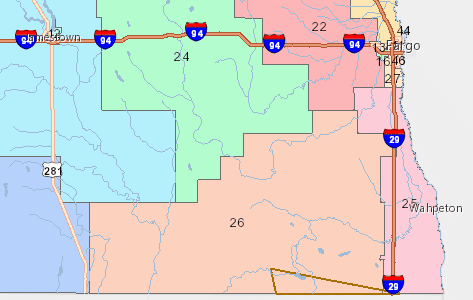

Three voting districts in North Dakota are about to disappear. That is, if proposed redistricting that reconfigures voting alignments meets with the approval of legislators. The matter will be taken up when the state’s legislators return to Bismarck November 8 for a maximum four-day session.
Can entire voting districts really disappear? How is that possible? Just up and vanish?
The answer is both yes and no. There is little doubt legislators will have some spirited discussion about what the state’s final new redistricting plan should look like. It is the number one topic on the agenda when the state’s lawmakers reconvene, to provide a necessary reconfiguration of voting boundaries, based on the latest census, to ensure equal representation for state citizens.
If the present redistricting plan is approved, Districts 10, 23, and 26 would be dissolved, or rather, replaced with different boundaries and designations. For example, District 10 is currently in the extreme northeast corner of the state. Under the new proposal District 10 moves to McKenzie County on the state’s western border where there has been a large increase in population since the previous census 10 years ago. The “old” District 10’s realignment transforms it into District 19.
District 23 will be similarly affected. That district in east-central North Dakota primarily covers a five-county region. As proposed, the District 23 designation would shift to the Williston area and what was previously most of District 23 would be replaced by a new realignment – District 29.
"Dissolution of [District] 26 was a bit of shock. Quite honestly, I think it was politically motivated."Rep. Sebastian Ertelt, R-Dis. 26, Lisbon
While legislators may have plenty to say, for and against, those reconfigurations, it is a third district, District 26, that is almost certain to spur heated debate.
District 26, in the southeast, is currently represented by Sen. Jason. G. Heitkamp, Wyndmere; and Representatives Sebastian Ertelt and Kathy Skroch, all Republicans.
“Dissolution of 26 was a bit of a shock. It caught us off guard,” said Ertelt. “Quite honestly, I think it was politically motivated. I don’t think you can choose otherwise.”
Heitkamp expressed a similar view when asked about the dissolution of District 26.
“The reason why District 26 is on the chopping block is that the three of us have done things that invigorated citizens but made people in power upset,” claimed Heitkamp. “Getting rid of every one of us, that shows a bad thing in the state.”
Heitkamp and Skroch live within the boundaries of proposed new District 25, in the extreme southeast corner of the state bordering Minnesota on the east and South Dakota to the south. That region currently makes up a portion of District 26, meaning they will continue to represent some of the voters that elected them. Ertelt however, will find himself living outside the proposed new District 25.
“I would be in District 24. Under the current plan I would be out of office with no election,” said Ertelt. “That is within the realm of politics, political motives whether we like it or not.”
The next scheduled election in District 24 will be in 2024 when legislators from all even numbered districts will be on the ballot. Ertelt says that under the proposed plan, voters who elected him will no longer be represented by him and will be “stuck with legislators they had no chance to vote for.”
“The most important thing is that we don’t disenfranchise voters,” stated Ertelt.
"In 20 hours [Rep. Ertelt] came up with a better plan than the state has for redistricting." Sen. Jason Heitkamp, R-Dis. 26, Wyndmere
Ertelt countered the redistricting committee’s proposed plan by drawing up his own proposal which kept District 26 in place, eliminating only District 23, and adding one district to keep the total district count at 47. The committee’s proposed plan eliminates three districts and adds three districts.
“I was trying to retain legislators within legislative districts,” explained Ertelt. “I’m not saying that was the right approach, just showing there was an opportunity to do that.”
Ertelt’s proposal was presented to the redistricting committee, composed of eight members from each legislative body, at the 11th hour and therefore didn’t receive a thorough review.
“The only significant pushback to my plan was that the committee received it on the final day they were meeting. They really didn’t object to the plan, but rather the timing of it,” said Ertelt.
“In 20 hours he came up with a better plan than the state has for redistricting,” remarked Heitkamp. Ertelt added that the duties of the redistricting committee were “not an easy task by any means” and intends to introduce an amendment at the upcoming session, once a redistricting plan is approved, to reduce the percentage of voters disenfranchised by redistricting to a maximum of 10%. Under the proposed redistricting alignment, said Ertelt, “roughly 30,000 voters” will be represented by legislators for which they did not cast a vote.
